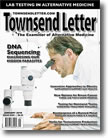|
![]()
From the Townsend Letter |
|||
Applied Kinesiology Essentials by Scott C. Cuthbert, BA, DC |
|||
|
Page 1, 2 Diagnostic Tools: 'Challenge' and 'Therapy Localization' Figure 3: AK Nutritional Challenge
Figure 4: AK Vertebral Challenge
Figure 5: AK Cranial Challenge
Figure 6: AK and Acupuncture Point (Bladder-1)
It is also characteristic of AK assessment procedures to move from the examination of the patient into the treatment almost immediately.44 As a clinician searches for information through the manual muscle test, the appropriate challenge or therapy localization to the responsible tissue or remedy will turn "finding" into "fixing." One treatment modality accompanies another as a rather "custom made" application is created that not only varies from patient to patient but should vary from one session to the next for a particular individual as a condition improves. Applied Kinesiology's Future in the Management of Stress-Related Illness Figure 7: Applied Kinesiology's Integrative Model of Health Care
There are now over 100 papers published in peer-reviewed journals on the methods and outcomes of AK.2-4,45 Few CAM therapeutic methods have been investigated or written about as extensively as AK. There have been 38 separate books published about AK methods since 1964.
Applied kinesiology offers an important diagnostic tool to supplement those already in place because it unifies within one diagnostic modality – the manual muscle test – the approaches commonly used throughout CAM. In considering how acupuncturists focus upon meridians, physiotherapists upon rehabilitative exercise, naturopaths upon nutrition, and chiropractors upon the joints, AK does not overrule the tenets of any of these approaches, but rather implies that human ailments may be attributed to multiple systems and that the MMT may identify these for the muscle tester educated in its use. This allows for an integrative and interprofessional model of health care to be developed.
Figure 8: Abnormal results of the manual muscle test may indicate abnormal involvement of any of the factors surrounding it. A change in muscle function when specific stimulation is applied to one of these elements also indicates dysfunction of the surrounding factors.
Dr. Scott Cuthbert is the author of Applied Kinesiology Essentials: The Missing Link in Health Care (2014) and Applied Kinesiology: Clinical Techniques for Lower Body Dysfunctions (2013). Dr. Cuthbert is a 1997 graduate of Palmer Chiropractic College (Davenport) and practices in Pueblo, Colorado. He has published 11 Index Medicus clinical outcome studies and literature reviews, and over 50 peer-reviewed articles on applied kinesiology. He is on the board of directors of the International College of Applied Kinesiology USA. |
|||
![]()
Consult your doctor before using any of the treatments found within this site.
![]()
Subscriptions
are available for
Townsend Letter, the Examiner of Alternative Medicine
magazine, which is
published 10 times each year. Search our pre-2001
archives for further information. Older issues of the printed magazine
are also indexed for your convenience.
1983-2001
indices ; recent indices. Once you find the magazines you'd like to order, please
use our
convenient form, e-mail subscriptions@townsendletter.com,
or call 360.385.6021.
360.385.6021
Fax: 360.385.0699
info@townsendletter.com
Who are
we? | New articles | Featured
topics | e-Edition |
Tables of contents | Subscriptions | Contact
us | Links | Classifieds | Advertise |
Alternative
Medicine Conference Calendar | Search site | Archives |
EDTA Chelation Therapy | Home
© 1983-2017 Townsend Letter
All rights reserved.
Website by Sandy
Hershelman Designs
![]()











